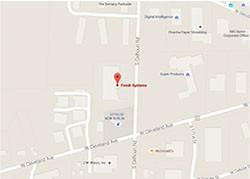We have mentioned viscosity in previous Newsletters and this month we want to discuss viscosity more in detail. It is important to know at what viscosity and spray gun set-up will I see a uniform quality finish, so future applications are repeatable.
Briefly, the viscosity of a material is an indication of its ability to resist flow. The flow characteristics of a viscous coating will require greater air atomizing pressure or pump pressure in the case of AAA or Airless equipment to obtain the uniform quality finish. Centipoise is a worldwide measurement of viscosity.
Always obtain a Product Data Sheets for each coating (March Newsletter). We cannot stress how helpful the data on these sheets are for establishing the initial coating spray viscosity, gun set-up, and pressure settings for a quality finish.
Unfortunately the coating world does not use a common viscosity tool (cup) to set the factory and/or field viscosity. There must be 12+ viscosity devices worldwide, with the most common in the U.S. being: Zahn, Ford, and DIN cups. Within each manufacturer of viscosity cups are cups with different capacities and orifices sizes for light, medium, and thick coatings
If we know the recommended spray viscosity in a Zahn, Ford, or DIN cup we can advise which gun orifice size and atomizing air pressure will likely be your starting point. Shown below is a viscosity conversion chart that allows you to cross-reference viscosities in seconds between four different viscosity tools (cups) at a given Centipoises. 25 degrees C. is equal to 77 degrees F.
|
Viscosity Conversions For Newtonian Fluids @ 25 deg. C., or 77 deg. F, D=1) |
||||||
|
Centipoises |
Ford Cup #4 |
Zahn #2 |
Zahn #3 |
Zahn #4 |
Din 4 |
Krebs Stormer |
|
1.0 |
|
|
|
|
|
|
|
10.0 |
|
16 |
|
|
|
|
|
15.0 |
|
17 |
|
|
9 |
|
|
22.0 |
13.6 |
19 |
|
|
12 |
|
|
32.0 |
15.3 |
20 |
|
|
15 |
|
|
50.0 |
19.0 |
22 |
|
|
17 |
|
|
65.0 |
22.0 |
27 |
|
|
20 |
|
|
85.0 |
27.0 |
34 |
|
|
23 |
|
|
100.0 |
30.0 |
41 |
12 |
|
28 |
|
|
125.0 |
36.0 |
49 |
14 |
11 |
30 |
|
|
140.0 |
40.0 |
58 |
16 |
13 |
32 |
|
|
165.0 |
46.0 |
66 |
18 |
14 |
39 |
|
|
200.0 |
50.0 |
82 |
23 |
17 |
46 |
52 |
|
225.0 |
55.0 |
|
25 |
18 |
50 |
54 |
|
250.0 |
68.0 |
|
27 |
20 |
55 |
56 |
|
275.0 |
74.0 |
|
32 |
22 |
64 |
59 |
|
300.0 |
81.0 |
|
34 |
24 |
67 |
61 |
|
320.0 |
86.0 |
|
36 |
25 |
70 |
62 |
|
340.0 |
91.0 |
|
39 |
26 |
74 |
63 |
|
370.0 |
99.0 |
|
41 |
28 |
79 |
64 |
|
400.0 |
107.0 |
|
46 |
30 |
86 |
65 |
|
435.0 |
116.0 |
|
50 |
33 |
94 |
66 |
|
470.0 |
125.0 |
|
52 |
34 |
100 |
67 |
|
500.0 |
133.0 |
|
57 |
37 |
110 |
68 |
|
550.0 |
146.0 |
|
63 |
40 |
122 |
69 |
|
630.0 |
167.0 |
|
68 |
44 |
134 |
71 |
|
885.0 |
199.0 |
|
|
64 |
|
78 |
|
1070.0 |
270.0 |
|
|
|
|
85 |
|
1290.0 |
|
|
|
|
|
95 |
|
1760.0 |
|
|
|
|
|
100 |
|
2270.0 |
|
|
|
|
|
105 |
|
2700.0 |
|
|
|
|
|
114 |
|
3620.0 |
|
|
|
|
|
129 |
|
4630.0 |
|
|
|
|
|
136 |
|
6340.0 |
|
|
|
|
|
|
|
9850.0 |
|
|
|
|
|
|
|
14800.0 |
|
|
|
|
|
|
Most coatings are formulated to be sprayed @ 73 to77 degrees F. Ideally, we want to check viscosity and spray the coating in this temperature range. However, in the real world we sometimes do not have the coating nor shop air temperature at 75 degrees F. Every effort should be made to obtain these temperatures for a uniform quality finish.
PROCEDURE
Equipment: Viscosity Cup, Stopwatch, and thermometer with coating temperature conversion chart.
: Prepare the material to be tested. Activate, reduce, mix, strain, etc.
: Raise or lower coating temperature to 77 degrees F.
: Submerge or fill viscosity cup with coating
: Raise cup out of coating or open flow from orifice and start the stopwatch.
: Always keep your eye on the orifice. When the stream breaks stop the watch and record how many seconds have passed. Now you have the data to determine if you are at the coating manufacturer’s recommended spray viscosity.
If you do not have a factory viscosity recommendation, and you have to try several viscosities on your own, please take the time to record your successful viscosity and coating temperature along with your gun settings in your “Coating Black Book.”
Handle: news/what-is-viscosity-and-why-is-viscosity-important-for-a-great-finish